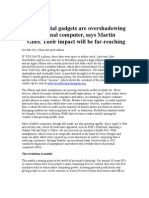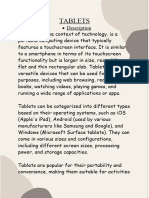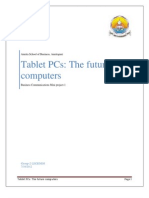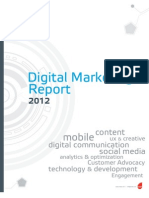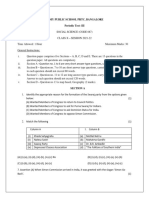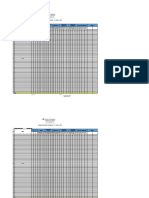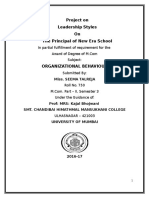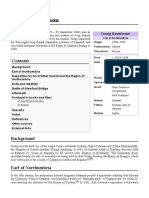Smash Hit!
The success of tablets in the marketplace
Ferdinand Sia and Gem Guiang
Alex, an ophthalmologist, reviews the profile of a patient on his iPad before seeing him at
Manila Doctors Hospital. To help him determine his patient’s visual acuity, he pulls out a Snellen chart
from this iPad and asks his patient to read the letters aloud from a distance, starting with the big letter
‘E’ at the top. Alex shows eye photos from his iPad to explain his patient’s condition before writing out
a prescription. Meanwhile, at home, his wife Amy uses her iPad to read her favorite novel, check out
new recipes, and connect with her friends in Facebook or Yahoo! Mail several times a day. Her two
small children, AJ and Saki, squeal with excitement as they play Fruit Ninja in their own iPad.
Like Alex, Amy, AJ, and Saki, most people use tablets to read documents, flash visual images
for presentation, consume multimedia content, and access online communications channels multiple
times a day. In most cases, people regularly visit fewer than 10 sites, among them, a search engine site
like Google, a social networking site like Facebook, an email and instant messaging site like Yahoo!, a
media site like YouTube, and games like Fruit Ninja.
Laptops and smartphones are simply not up to the job
As people continue to access more favorite applications in the Net more frequently, laptops
appear to have become too cumbersome to use. Every time one wants to access applications with a
clamshell laptop, one needs to lift up the display panel, run the system’s long boot up sequence, connect
to the Internet, and, with laptop’s generally limited battery life, plug it into an outlet. The steps and
waiting time involved entail an uncomfortable discontinuity, impatience, and loss of excitement.
On the other hand, while smartphones may be more suitable for frequent online content access
than laptops as they are designed to be constantly powered-on and connected to the Internet, all the
same, reading content in a smartphone can be painful to the eyes because of the contraption’s small
screen size. The ease, convenience and enjoyment experienced derived from surfing the web, checking
social networking sites, and playing videogames in smartphones are just not the same as in a wider
screen device.
The shortcomings of both devices leave a vacuum for spontaneity in terms of content
consumption and communications.
Tablets are better for content consumption
Tablets are touchscreen mobile PCs that do not come with a dedicated keyboard or mouse.
Beyond this physical attribute, however, tablet users know that these cool devices offer something more:
an emotional experience that we call spontaneous motion – a pleasant, enjoyable experience owing to a
natural and uninhibited flow of thoughts and actions without unnecessary human exertions. The
convenience, portability, and simplicity of tablets help create this unique experience.
Page 1 of 3
� In particular, a tablet enables a person to immediately satisfy a persistent urge to access content
and updates. Like a smartphone, a tablet is constantly powered on, such that consumers can swiftly
activate an application with one simple touch of the gadget, any time they feel like it. The steps involved
in operating a tablet are simpler and the waiting time is shorter, leading to undisrupted content
experience. In addition, accessing favorite applications multiple times a day is more enjoyable with a
tablet than a laptop. Because it has a wide screen, a tablet displays web sites like standard web pages
rather than mobile phone-optimized size, leading to a more natural viewing experience. Lastly, given a
tablet’s lightness, its long battery life and notepad design, people can access applications like they can
with a mobile phone.
Because of the tablet’s ability to provide spontaneous motion, it has created a new category in
the consumer electronics space. Tablets are now positioned as simple mobile devices that offer the
convenience of a smartphone and the functionality of a laptop, especially for people who seek a
spontaneous motion experience in content consumption and communication. In contrast, smartphones
give people control, security, and a sense of belonging. They are used for voice communications,
messaging, listening to music, and light Internet browsing. For their part, laptops have become central to
earning a living in the 21st century, having become indispensable tools for content creation, e.g., reports
and graphics, and organizing information.
Tablets – A whopping success!
Today, tablet sales are estimated to account for 11% of the global computer market, a significant
percentage that goes beyond the size of innovators and early adopters – traditionally the first market
segments to adopt a new product before the mainstream market follows. Sales continue to grow as more
and more people have signified interest in acquiring a tablet, fueled by the recommendations of those
who already have experienced and benefited from the product. This phenomenon is remarkable, in light
of the fact that many innovations have failed in the market.
Most new products have remained unpopular because companies that create them tend to
overlook the behavior of customers. We hear about status quo bias where people tend to stick with what
they have even if a better alternative exists. In general, people irrationally overvalue the status quo and
are often skeptical about a new product. For example, people do not switch between telecom service
providers merely because they want to retain their existing numbers, even if they know that another
provider offers better service.
In addition, people are naturally reluctant to try out a new product if doing so will require them
to change their behavior. The bigger the behavioral change required, the bigger the consumer resistance
will be. Consumers will adapt to new behavior only if the benefits are significant enough to outweigh
the hassles of changing behavior. Needless to say, an innovative product offering noteworthy benefits
and demanding minimal change in usage behavior is poised to sell exceptionally well in the market.
Tablets have surpassed these two behavioral hurdles. First, owning a tablet does not render
ownership of a laptop or smartphone moot or redundant. Instead, it adds value to the gadgets already
Page 2 of 3
�owned, by functioning as a complementary product rather than as a substitute for either. Second, a tablet
does not require consumers to change behavior, especially if they already have a touchscreen
smartphone. Applications in a tablet are chosen they way they are in a touchscreen smartphone: by
tapping or swiping icons on the screen. A tablet’s having the functionality of a laptop and the familiar
user interface of a touch screen smartphone make it fit seamlessly into everyday behavior.
In the words of Geoffrey Moore, a guru in technology marketing: "Customer use is the starting
point for innovation, not customer need.” The tablets’ ability to provide spontaneous motion experience
and ease of customer use are what the product such a smash hit.
Ferdinand Sia is connected with a global consulting firm, while Gem Guiang is affiliated with a
technology firm. Feedback the authors at marketingmetrics@yahoo.com
Page 3 of 3












